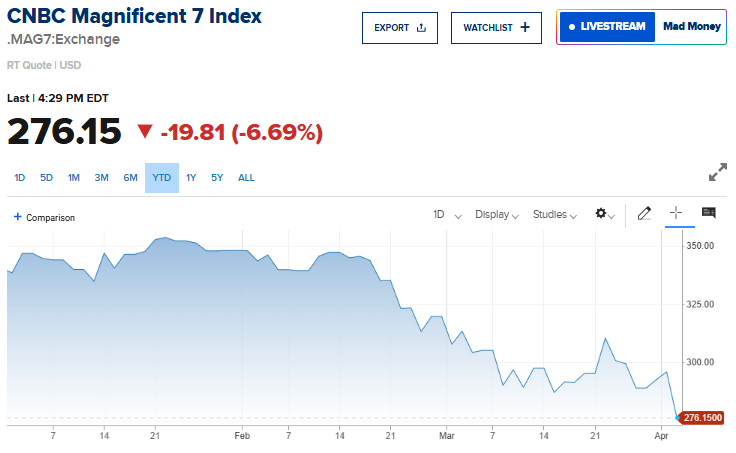Amazon’s many platforms (and savior of malls?)
Don’t forget this week’s Live Q&A Chat at 2pm ET today at http://twc.scutify.com/members, on the TWC App, or just hit reply to this email and send in your question. Ask me anything at all about the markets, the economy, trading strategies, tech revolutions, politics, news, apps, cooking, sports, TV, books, real estate, oil — I’m serious, ask me anything.
We moved my medically-fragile daughter Amaris home and my wife and I had our first night alone at home with our two girls last night, after seven months of living away. Here’s a video of Amaris and me playing last night.
It was another ugly morning’s trading session with the $DJIA down -200 at the lows, though it’s now rallied back to even. Again no trades for me today, at least so far, as I wait for better pitches. It’s so important to never force trades. Let the high-reward/low-risk trades come as they may.
Flip It! This is so brilliant on so many levels: Amazon is opening hundreds of physical bookstores.
Those of us who were around for the original Dot Com Bubble back in the late 1990s, remember how Amazon was originally just a book seller. I remember stepping outside from my work as an analyst at a tech incubator company to go to the gym for Tiger Shulman’s Karate classes and seeing a pick-up truck pulling a 10 foot tall, 20 foot long sign on a trailer behind it that said “Amazon.com Books.”
And Amazon first disrupted the book retailer industry long before it became a place to buy tech gadgets, clothes, rubber bouncy balls, and garden supplies and that was long before it became a place to buy/subscribe to music, TV and movies, and cloud services.
And over the years, as Amazon Prime has caught on with its free two-day shipping and $3.99 over night shipping and charging no sales tax (or income tax for that matter).
Of course, let’s be clear that while I think it’s great as a shareholder that Amazon’s able to provide all these services and sell me all these retail goods at little or no tax consequence. But as a citizen of this country, it makes me furious to no end that Amazon is able to use our roads, courts and other public services without having to pay much if anything for them. Amazon’s ability to avoid sales tax makes it an unlevel playing field against most other retailers and tremendously unfair to small local retailers around the country who do pay sales tax, income tax and other taxes to support our public services and infrastructure. Again though, as an investor, it’s clear that being able to avoid taxes and riding that unlevel playing field has created some self-fulfilling cycles that benefit Amazon.
Amazon’s remarkable growth as a retailer, subsidized or not, destroyed the mall and the mall culture that I grew up in. It was always a big deal to get to go to the mall when we’d visit bigger towns than mine that had them, and malls were places to shop, hang out, play video games and otherwise rabble rouse. But nobody goes to malls any more, certainly not to hang out or as a destination target when traveling.
So after spending the first twenty years of its existence killing off the mall business, Amazon’s now about to save America’s malls. Last night Sandeep Mathrani, chief executive of General Growth Properties answer an analyst’s question on their earnings report conference call with the statement, “You’ve got Amazon opening brick-and-mortar bookstores and their goal is to open, as I understand, 300 to 400 bookstores.”
I think the term “bookstore” might be a bit misleading here. Amazon Stores will likely be much more than just bookstores. Amazon Stores will help the company continue to develop its logistics for delivery and returns and so on. Amazon’s going to try to create stores that sell books but that are more akin to Apple’s retail stores than they are to the old Barnes & Nobel’s book store model.
And guess what. Most any mall operator in America is desperate for another potential hit store like the Apple Store and that means that Amazon’s going to be able the concept of becoming an “anchor tenant” in those very same malls that have long suffered from Amazon’s dominance. Malls are desperate for tenants, especially an kind of an anchor tenant that could help provide a halo effect and foot traffic for the rest of the mall. Being a long strong buyer in a market full of desperate sellers is a good position to be in. Want to bet that Amazon pays almost nothing for their retail mall spaces?
Amazon’s got more growth ahead of it and now every brick and mortar retailer in the country has even more to worry about. I’ve owned Amazon for a very long time and though I sold quite a few shares back in November when the stock was near $700, I’m not rushing back into them just now. That said, this stock is quite oversold here and likely to bounce 5-10% near-term. Feet to fire, that is.
Here’s some of my Amazon analysis from back in 2012 when I was buying more of the stock. And it still applies well today and even moreso as Amazon adds a physical brick and mortar strategy to the Amazon-As-A-Platform concept that I discuss below:
July 3, 2012 – “There’s lots I could highlight, how Amazon is disrupting the entire publishing value chain, that they have a seat in your living room by offering free streaming content to Prime subscribers or how they’re becoming the de facto online shopping jumpoff. But what I really care about is Amazon As Platform (or AAP). My vision of what Amazon is trying to do is simple: they are trying to be the platform for all things e-commerce. Think of Amazon as an operating system and every brand or individual selling through Amazon as an app.
In ten years I see companies with significant catalog businesses, like say, a Williams-Sonoma WSM, shifting their fulfillment to Amazon. So WSM would still get the bulk of revenue but they will do the bulk of their business through a curated sellers page on Amazon. Selling on the Amazon would undoubtedly bring in more revenue, the question is when retailers accept that they need to be on Bezos’s platform, and how long they’ll cry cannibalization. The scale of the fulfillment and platform business makes enormous sense for Amazon; WSM for example has about $3 billion in revenue, and capturing 10% of that for platform services might look small but multiply that by about 50 other companies of similar size and you add about 10% to Amazon’s current revenue picture.
And I love, love, LOVE Amazon’s push into product subscriptions. If you haven’t used it already pick a product that you buy with regularity, like toilet paper (sorry for that one Mom). Buy in bulk and Amazon matches the absolute lowest-cost vendor out there, Wal-Mart WMT on the price for Charmin Ultra Soft, Double Rolls, 4 count packs, ($3.36). And if you consider the scale of Wal-Mart’s retail network and realize that’s what it takes for Wal-Mart to sell toilet paper that cheaply and take 1% cut, you’ll start to appreciate just how revolutionary Amazon’s platform is.
Sure, you’ll always need to run to the store and pick up a couple basic items, but consumers, over time, will shift their basic purchases online, not just discretionary ones. And if you plan, and try to save money, and seriously, who isn’t trying to do that right now, you can buy your toilet paper through Amazon’s subscription service, delivered free to your door, for 5% under Wal-Mart’s price. Right now ecommerce is less than 9% of total retail sales, or about $160 billion. And right now retail sales are often talked about in terms of ‘ex-Wal-Mart’ because the Bentonville giant is fully 11% of all retail in America. Over the next decade, not only will the overall retail pie grow, but the ecommerce portion will tip to over 20% and Amazon will have an enormous piece of that. You want to be long Amazon before analysts start talking about the retail economy in of ‘ex-Amazon’ terms.
Amazon as an agnostic fulfillment platform terrifies Google. If consumers come to see Amazon as the lowest cost option, they’ll stop searching on Google to buy stuff and that would be an enormous hit to AdWord revenues. Which is why Google is trying to assemble a Prime-like shipping service of their own, and is desperate to sign up retailers like Macy’s M and OfficeMax OMX. Amazon is building their video offerings to be a genuine competitor to the ‘dumb’ cable and satellite networks. By allowing their Instant Video service to stream on set-top boxes like Roku, Amazon is piggybacking on an existing user base and wifi networks to win living room and mobile ‘shelf space’. The last 50 years of how consumers interact with TV won’t be how they do it in the next 50, and Amazon is making their video platform ready for a huge upcoming slate of social media video apps, like Shelby.
So without the massive capital investments that cable companies have to make to just stay in business, Amazon is creating a rival platform that can aggregate and sort video and deliver it to your living room or your smartphone. I predict that within the next two years they start working with a TV manufacturer and create an Amazon TV that will seamlessly stream content without a cable subscription. And five years from now Amazon will probably be a top 5 smartphone vendor. Amazon is using Google’s Android right now to power their Kindle fire but they have such an enormous and dedicated user base that I see the Kindle becoming a platform in it’s own right, not just another generic Android device. Buying Amazon before their revenue mix includes data plans and retransmission fees and all sorts of stuff that traditional distribution networks own right now is a revolutionary bet.”



